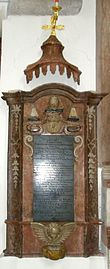Julius Heinrich von Rehlingen-Radau
Julius Heinrich Freiherr von Rehlingen-Radau (born August 27, 1662 in Augsburg ; † June 19, 1732 ) was an Augustinian canon and from 1723 to 1732 Prince Provost of Berchtesgaden .
Live and act

His father was Franz von Rehlingen (1607–1675), councilor in Augsburg, his mother was his second wife Rosina Brunn from Burghausen.
What is particularly noteworthy about the term of office of Julius Heinrich von Rehlingen-Radau is that it ended the 128-year Kurköln administration of the Principality of Berchtesgaden. The three administrators as predecessors in office were characterized by their ongoing, but in the end hardly successful efforts to protect against the Salzburg archbishops ( see also: War of the Spanish Succession ). In addition, due to the mostly very low presence of these regents, especially under the direct predecessor Joseph Clemens of Bavaria , the monastery “got on a sloping path”. This was also expressed in the end by a debt level of 120,000 guilders , which von Rehlingen-Radau had to take over. But these debts were based not least on the luxurious and “unworthy” way of life of the Augustinian canons .

For example, von Rehlingen is mentioned as early as 1715 as the dean of the prince provost, who felt compelled to ask the citizens of Berchtesgaden to provide evidence of good repute for his and his fellow Augustinian canons . He himself was accused of rarely coming to the choir, of not wearing religious clothing, of powdering his hair and of dining with the wives of the officials in his own room. In addition, little obedience would have been shown to him as the collegiate dean. When Joseph Clemens von Bayern then excluded the Baron von Rehlingen from the Berchtesgaden government and he also insisted on spiritual discipline (disciplinam religiosam) of the canons, the chapter concluded, bearing in mind his documented right to free choice, in future no foreigners and certainly no more Wittelsbach princes to choose their regent. And so von Rehlingen was only chosen as coadjutor and after the death of Joseph Clemens in 1723 as prince provost. According to the principle: "following the holy spirit, no longer following the spirit of the Bavarian court". As a result, the offended Bavaria stopped exporting grain to Berchtesgaden and reduced the price of salt. When von Rehlingen declared in return that he would rather close the Berchtesgaden salt mine than continue to be depressed in this way, Bavaria gave in again.
During his term of office and reign as provost, three pilgrimage churches in the Rococo style were built in the course of the Berchtesgaden Counter-Reformation . In 1725 in what is now the Marktschellenberg district of Ettenberg, the pilgrimage church of the Visitation of the Virgin Mary and on the northeast slope on the Berchtesgaden side of the Lockstein the “Hilgerkapelle”, formerly also called “Maria Dorfen”. Towards the end, construction of the Maria Himmelfahrt church (also known as Maria Kunterweg ) began in Ramsau near Berchtesgaden in 1731 and was completed in 1733 under Cajetan Anton Notthracht von Weißenstein .
After a comparison of August 8, 1730 between Salzburg and Berchtesgaden about the titles of the two regional offices, Berchtesgaden was officially only allowed to refer to itself as “princely” and “ imperial pen ”, but no longer as “high princely” and “ bishopric ”.
Julius Heinrich Freiherr von Rehlingen-Radau died on June 19, 1732 and found his final resting place under a stone grave slab next to his grave monument in the collegiate church in Berchtesgaden.
literature
- Walter Brugger , Heinz Dopsch , Peter F. Kramml: History of Berchtesgaden: Between Salzburg and Bavaria (until 1594) . Plenk, Berchtesgaden 1991, pp. 284, 287.
- Manfred Feulner: Berchtesgaden - history of the country and its inhabitants . Berchtesgadener Anzeiger publishing house , Berchtesgaden 1986 ISBN 3-925647-00-7 , pp. 163-186.
- A. Helm , Hellmut Schöner (ed.): Berchtesgaden in the course of time . Reprint from 1929. Association for local history d. Berchtesgadener Landes. Verlag Berchtesgadener Anzeiger and Karl M. Lipp Verlag, Munich 1973. pp. 100, 106–111, 261–262.
Web link
Individual evidence
- ↑ a b On the origin and date of birth of Julius Heinrich von Rehlingen-Radau - u. a. in Walter Brugger, Heinz Dopsch, Peter F. Kramml: History of Berchtesgaden: Between Salzburg and Bavaria (until 1594) . Plenk, Berchtesgaden 1991, pp. 284, 287.
- ↑ a b Joseph Ernst von Koch-Sternfeld : History of the principality of Berchtesgaden and its salt works. Volume 3. Joseph Lindauer, Salzburg 1815, from p. 61 f. ( Full text in Google Book Search).
- ↑ a b c Manfred Feulner: Berchtesgaden - history of the country and its inhabitants . Pp. 163-165
- ^ During the term of office of Julius Heinrich von Rehlingen-Radau - u. a. in Walter Brugger, Heinz Dopsch, Peter F. Kramml: History of Berchtesgaden: Between Salzburg and Bavaria (until 1594) . Plenk, Berchtesgaden 1991, pp. 284, 287.
- ↑ Manfred Feulner: Berchtesgaden - history of the country and its inhabitants . P. 186
- ↑ Manfred Feulner: Berchtesgaden - history of the country and its inhabitants . Pp. 176-179
| personal data | |
|---|---|
| SURNAME | Rehlingen-Radau, Julius Heinrich von |
| ALTERNATIVE NAMES | Rehlingen-Radau, Julius Heinrich Freiherr von (full name) |
| BRIEF DESCRIPTION | Religious, prince provost of Berchtesgaden (1723–1732) |
| DATE OF BIRTH | August 27, 1662 |
| PLACE OF BIRTH | augsburg |
| DATE OF DEATH | June 19, 1732 |